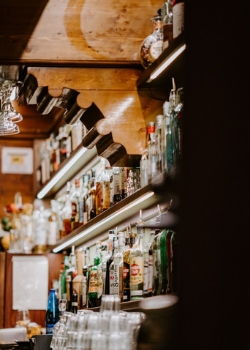Super Early Deadline
30 November 2025
Judging
Date
24 & 25 March 2026
Winners Announcement
22 April 2026
30 November 2025
24 & 25 March 2026
22 April 2026

From hero to zero in less time than the time, it takes to send a shipment of tequila from Mexico to Europe. It’s just a year since the demise of Conviviality, one of the quickest corporate collapses the UK drinks industry has ever seen. Just a few months before it was at the very top of the UK’s drinks wholesale and distribution market, capitalised at an all-time high of £747m after hoovering up its competitors.
Whilst the collapse was immediate and ‘terminal’ for shareholders, the company brought down in large measure by Its lack of (financial) control processes (including the ‘discovery’ of a £30 million tax bill owing to HMRC), it’s immediate effect on the drinks distribution industry was fortunately pretty short-lived with the administrators able to sell of parts of the business as going concerns who were then able to assure customers that it was ‘business as usual’.
Clearly, for anyone caught up in the ensuing storm it likely caused a few sleepless nights, after all, Conviviality Direct was the country’s largest on-trade independent wholesaler supplying getting on for 25,000 establishments.

This debacle is only one of several episodes that have changed the distribution landscape over recent years and follows on from other events, like the arrival of Amazon in the grocery sector, as well as their tie-up with Morrisons on fresh, chilled and frozen produce deliveries. Previously, Carlsberg had outsourced its distribution, and now Fullers are selling all their brewing and distribution interests, a deal that itself is only the latest in a long line of mergers and acquisitions between brewers. All of which points to a continuing dynamism in the food and drink supply chains that are likely to lead to more changes, more consolidation from what is still a relatively fragmented industry made up of several thousand players. Simultaneously the situation opens up opportunities for smaller importers and distributors, with those in the middle more likely to struggle. As a producer or brand owner, the direction is clear – find your niche.
Traditional supply chains have also been put under growing strain by the considerable expansion in internet shopping, part of increasing consumer demand for greater convenience – today, consumers can get a bottle delivered to their home or place of work in an hour – and the seemingly ever-lower levels of consumer brand loyalty, where ‘best-price-for-the-same-quality' (by some estimates, up to 40% of sales are made as part of promotional offers) are all major drivers in consumer buying decisions.
When you throw in the still unresolved Brexit conundrum and the future trading relationship with the EU and the rest of the world, not to say continuing access to labour from the continent, supply continuity remains very much an on-going issue and should be on the watch list of everyone working in the on- or off trade.
However ‘plus ça change, plus c’est la plus même chose’ as the old French cliché goes. Is what we see on a macro level driven by what we already see from the ground floor?
Whilst, for a time, it seemed as though big distribution companies were taking over everything, it now seems that things have come full circle. Back to a time when drinks companies were smaller, niche operators, reflecting the fact that alcohol is not a need but a want. In fact, pinnacling the want side of human nature so that we are prepared to spend much more money for something smaller, more exciting, and more flavoursome.
With the growth in craft and niche products, and an increased focus on personalisation leading to the marked innovation trend we see today were ‘different means good’. For example, an individual’s personal gin brand repertoire is now reported to be as many as 6 or 7, something that would have been unheard of even 10 years ago.
As the market for niche, different, high-end, quality, authentic, craft and artisan (and often ‘small scale’, although sometimes within a larger company) has become mainstream, so these different distribution channels have been broken up into small(er) niches. A gastro pub or restaurant does not (just) want Gordon’s gin, so they start hunting for a drinks distributor with something different. This will usually mean a smaller distributor, one who doesn’t want to, or can’t, physically take over their whole bar. That outlet then has several supplier relationships, where once there might have been one or two.
Market research underlines this, as less than 1% of UK alcohol distribution companies employ over 100 people, whereas over 75% employ no more than 4 people.
As a new beer or spirit brand comes to the UK market, whilst it’s the network that makes things happen, it’s the combination – and synchronisation – of the people, the product, a story-well-told, market timing, and differentiation that allows that execution to happen dynamically.
It’s critical to line up all of these complex factors so that distributors are prepared to have a look at your brand, and to make a judgement as to what it does, and how it does it, and then be prepared to invest their company’s and their staff’s time into creating profits for them as well as you.
All these factors mean it’s not an altogether off-the-wall view to look at what it might require to take actual control of the supply and distribution chain that have previously been handled by third parties.
In this scenario, winemakers and drinks producers can look to get more directly involved in more parts of the drinks industry by, say, partnering with a specialist restaurant distribution business, or by setting up distribution offices in key markets, or partnering with specialist suppliers, or buying into a wine agency and brand business, or working with an online e-commerce business, or even buying into a restaurant, hotel or pub chain, a vertical integration paradigm that brewers successfully adopted some time ago, pushing drinks products directly to the consumer.

The article is contributed by Alistair Morrell, Wine Inspector, wine industry consultant, journalist and, commentator. Over 30 years as a wine business professional, Alistair shares his global knowledge, network, and experience of growers, importers, distributors and buyers.
Show your spirits where it matters. Get your products tasted by top bartenders, buyers and experts at the London Competitions — enter now.